
Scientists' discovery of exotic black hole, a 'needle in a haystack' moment
text_fieldsIn a galaxy close to our own Milky Way, astronomers have discovered what they call a cosmic "needle in a haystack" — a black hole that appears not only dormant but born without the explosion of a dying star.
Researchers said on Monday that it differs from all other known black holes in that it is "X-ray quiet" — does not emit strong X-ray radiation — indicating that it pulls nearby objects with its strong gravitational pull — and is not born in a supernova, a stellar explosion.
Black holes are cosmic bodies of extremely intense gravity where nothing, even light can escape.
Nine times more massive than our Sun, this black hole was found in the Tarantula Nebula region of the Large Magellanic Cloud galaxy, 160,000 light-years from Earth.
A light year is a unit of measurement that is used to calculate the distance light can travel in a year, which is 5.9 trillion miles (9.5 trillion kilometres).
A very bright and hot blue star with a mass 25 times that of the Sun orbits in a stellar marriage with this black hole, Reuters reported.
This binary system is named VFTS 243. Researchers believe that the companion star will also become a black hole and merge together.
Dormant black holes, which are considered relatively common, are difficult to detect because they interact so little with their surroundings. Several previously suggested candidates have been ruled out after further study, including by members of the team that discovered this black hole.
Tomer Shenar, a research fellow in astronomy at Amsterdam University, lead author of the study published in the journal Nature Astronomy said, "The challenge is finding those objects," adding, "We identified a needle in a haystack."
Kareem El-Badry of the Harvard & Smithsonian Center for Astrophysics, an astronomer and study co-author said, "It's the first object of its kind discovered after astronomers have been searching for decades.'
Six years of observations from the European Southern Observatory's Chile-based Very Large Telescope were used by the researchers.
Black holes are categorised in different ways. Stellar-mass black holes are the smallest type, formed when a massive star reaches the end of its life and implodes, collapsing in on itself. The newly discovered one belongs to this category.
There are intermediate-mass black holes and supermassive black holes that reside at the center of most galaxies.
"Black holes are intrinsically dark objects. They do not emit any light. Therefore, in order to detect a black hole, we usually look at binary systems in which we see one luminous star moving around a second, not-detected object," said study co-author Julia Bodensteiner, a postdoctoral research fellow at the European Southern Observatory in Munich.
It is generally believed that supernova explosions are the cause of the collapse of massive stars into black holes. This black hole was created without an explosion when a star 20 times the mass of our Sun collapsed in on itself after ejecting some of its material into space in its last moments.
The lack of explosion can be understood by the shape of its orbit with its companion. "The orbit of the system is almost perfectly circular," Shenar said.
Had a supernova occurred, the force of the explosion would have kicked the newly formed black hole in a random direction, giving it an elliptical rather than circular orbit, Shenar added.
Black holes can be relentlessly ravenous, gobbling up gas, dust, stars — any material that comes close under its gravitational pull.
"Black holes can only be mercilessly ravenous if there is something close enough to them that they can devour. Usually, we detect them if they are receiving material from a companion star, a process we call accretion," Bodensteiner said.
Shenar added, "In so-called dormant black hole systems, the companion is far enough away that the material does not accumulate around the black hole to heat up and emit X-rays. Instead, it is immediately swallowed by the black hole."
























